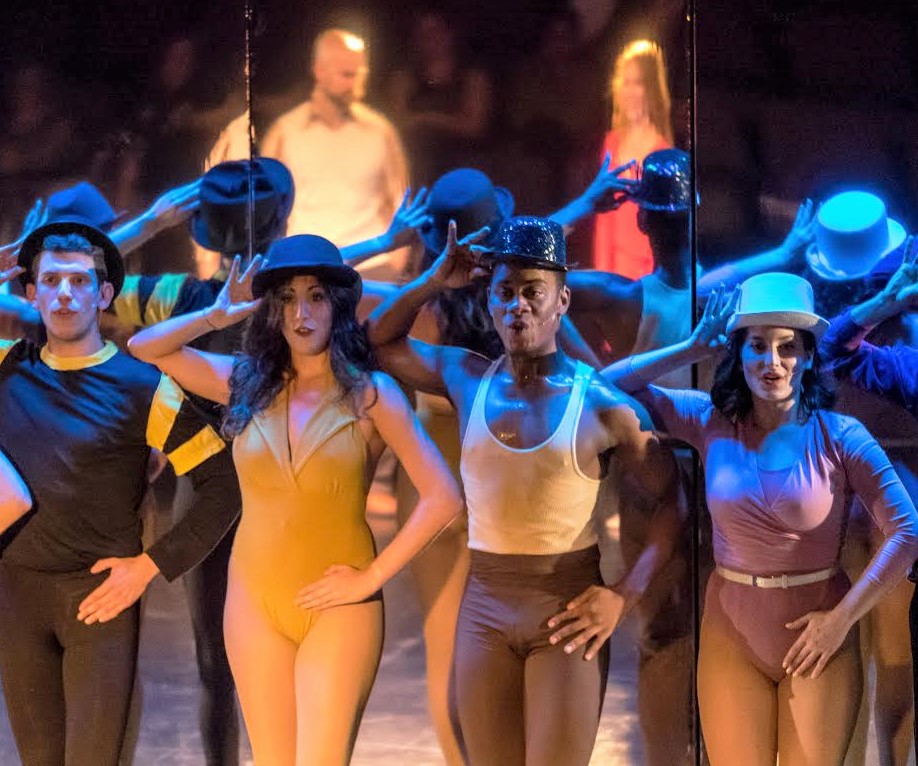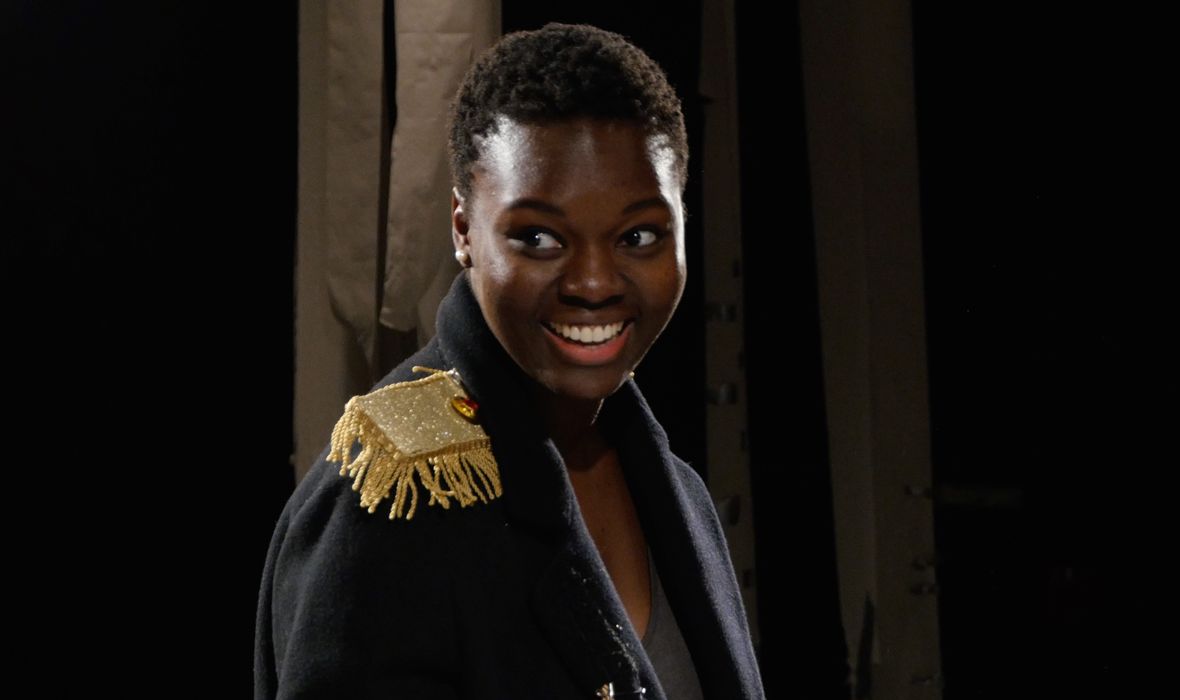Review of Antarctica! Which is to Say Nowhere, Yale Summer Cabaret
“Only the most oppressive seriousness can find a bond with lawless farce.”—Irving Howe
Howe’s comment about the relation of seriousness and farce might seem apropos while viewing Antarctica! Which is to Say Nowhere, Miranda Rose Hall’s new adaptation of Alfred Jarry’s Ubu Roi, directed by Elizabeth Dinkova at the Yale Summer Cabaret. The seriousness does indeed become a bit “oppressive” at times, but then the “lawless farce” of our times serves as excuse. Jarry’s chaotic and comic original was a successful effort to “épater les bourgeoisie” in turn-of-the-century Paris, and Hall’s incarnation aims to skewer not so much the things our day holds sacred as the things we should find shameful. Its targets—like climate change and our attachments to heated pools, central air, and personal computers—are apt to be matters that inspire liberal hand-wringing more than laughter, and to keep us at least chuckling is no small feat, in all seriousness.
Briefly (there are nearly 40 distinct scenes): the show introduces Roy (Marié Botha) and his wife Rena (Ricardo Dàvila) as bored but ambitious Americans who want to find new lands to conquer. Antarctica seems promising, so, accompanied by their newly hired “general” Linda (Emily Reeder), aka “General Electric,” they set off so Roy can become “middle management” for the royal family of Emperor Penguins (Yagil Eliraz, Rebecca Sherman Hampe, Steven Lee Johnson) that rule the creatures there. Roy, a blustering idiot with an insatiable appetite, is driven, Lady-Macbeth-style, by his power-mad wife, the brains of the outfit, who also entertains Linda’s desires to shut out Roy and take his place at Reena’s side.
A Penguin Leader (Patrick Foley) (photo: Christopher Thompson)
The blood-thirsty betrayal of the benign Emperor Penguin King (played with oafish aplomb by Eliraz) establishes a coup, but the son, Freddy Prince (Johnson, given to anxious, Hamletian soliloquy), escapes, possibly to wield revenge at a later date. Once in power, the Roys are as insufferable as you would expect, setting up fights to the finish between animals and glutting themselves on whatever comes to hand. As a portrait of American foreign policy, the Roys have all the subtlety of the self-serving Invasion of Iraq; in other words, they have the greed and none of the generosity of textbook versions of American intervention that have been tainted by—take your pick—slavery, the treatment of Native Americans, the war in the Philippines, the Bomb, the war in Vietnam, etc. And, as you’d expect with an American couple and a lifestyle of the rich and fatuous, soon enough there is the threat of civil war as Rena and Linda are imprisoned for insubordination. They escape and visit the North Pole—where an amusingly sleazy Santa (Eliraz) rules—and where Linda insists on enlisting an army of polar bears to overthrow Roy.
Roy (Marie Botha) (photo: Christopher Thompson)
As “subjects” to the self-installed American royalty, the creatures of Antarctica are all hapless and charmingly innocent. A late song in which Roy, very much a feeble Macbeth, tries to enlist his army of snowmen (Eliraz, Hampe) against his wife is a case in point. The song’s martial frenzy is undermined by the timid snowmen’s fear of just about everything. Christopher Ross-Ewart’s songs are entertaining and in the hands of the capable hands of the cast play the role tunes do in Disney cartoons—as moments of lyrical commentary or soliloquy. Rena’s punk trio’s statement of intent upon reaching Antarctica is a high-point, as is his touching duet with Reeder, and Foley's penguin parade is like a demented Dick Van Dyke from Mary Poppins.
Roy (Marie Botha, seated) with walrus henchman (Yagil Eliraz, Patrick Foley, Rebecca Hampe) and silhouettes of Rena (Ricardo Davila) and Linda (Emily Reeder) (photo: Kristian Rasmussen)
The show’s strength derives from the very capable clowning on view from an ensemble (Eliraz, Hampe, Foley) adept at silly voices and inhabiting cut-outs of creatures, and from Dávila’s remarkable Rena, played in non-campy drag, and somehow managing a rather heavy-handed treatise on the best way to abuse class divisions in the democratic process. Botha’s Roy is a fierce portrait of the kind of sociopath always capable of mirroring some portion of the American electorate. By way of characterization, Hall gives him a rambling discourse of disconnected white trash memories and a recurring dream—for him, too horrible to relate—of a french fry drowned in a tsunami of ketchup. As the driven Linda, Reeder seethes with a comic hostility that makes her appear, by the end, more power-mad than her unstable employers.
The transitions between the many, many short scenes—some a bit too similar in tone and pace—undermine the presentation at times, since simple blackouts can’t always suffice to get us from one scene to the next. The cast is game and nimble and to be commended for keeping so many creatures—penguins, seals, whales, etc.—distinct. And for making this varied visit through the unreclaimed id of our national psyche come alive with an oxymoronic sense of epic skit-comedy. Puppets and costumes by Sarah Nietfeld, including the penguin headgear used to surprisingly expressive effect, do much to set the tone, while set (An-Lin Dauber) and lighting (Andrew F. Griffin) work hard to establish—instantaneously—a variety of settings and events. The ending is a frantic case in point, as all levels of story and allegory converge in a moment that aims for the catharsis of being put on the spot.
Deceptively silly, Antarctica! Which is to Say Nowhere is angry as all true satire is, but, as theater, might benefit from a bit of Olympian laughter. But then, the show doesn’t make us laugh at ourselves so much as make us wonder why we’re able to laugh at all.
Antarctica! Which is to Say Nowhere
Based on Ubu Roi by Alfred Jarry
By Miranda Rose Hall
Directed by Elizabeth Dinkova
Costume and Puppet Designer: Sarah Nietfeld; Set Designer: An-Lin Dauber; Sound Designer & Composer: Christopher Ross-Ewart; Lighting Designer: Andrew F. Griffin; Production Manager/Technical Director: William Hartley; Stage Manager: Cailin O’Rourke; Production Dramaturg: Gavin Whitehead; Run Crew: Ece Alpergun; Tap Dance Consultant: Leora Morris
Cast: Marié Botha; Ricardo Dàvila; Yagil Eliraz; Patrick Foley; Rebecca Sherman Hampe; Steven Lee Johnson; Emily Reeder
Yale Summer Cabaret
June 30-July 10, 2016























































